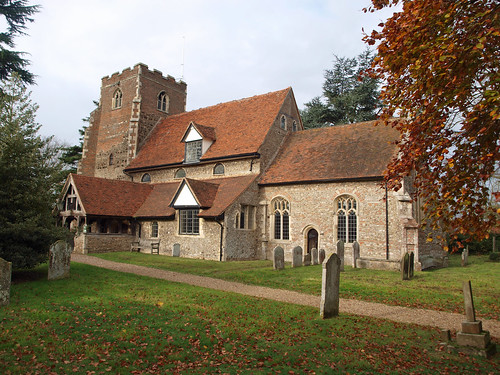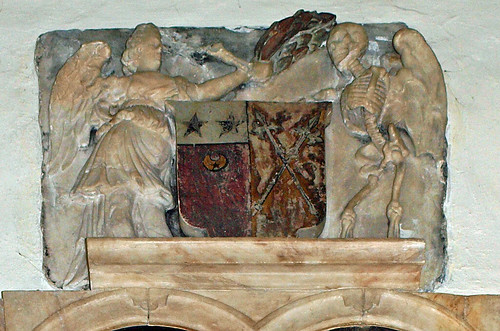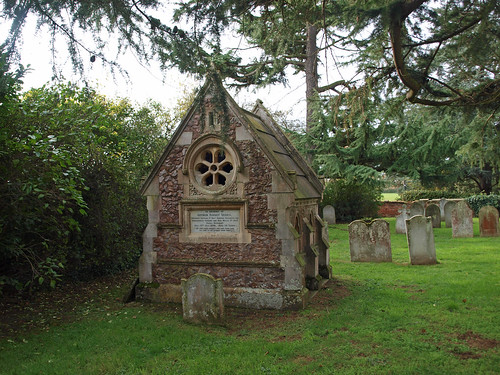St Peter is nothing spectacular but is a nice, stolid north Essex church with two rather odd dormer windows, one on the nave roof and one on the south aisle. It's main interest is derived from the history of non-conformism amongst the villagers and incumbents.
In the early part of the 15th century some Boxted parishioners were Lollards. Two Boxted men, including the holy water clerk William Sweeting, were arrested,The clerk was condemned and burned at the stake at Smithfield. Two other Lollards were arrested in 1531, one being condemned. From 1528 heretics, probably Lollards, from Colchester and Steeple Bumpstead attended readings from the New Testament, and the “Wicket" at the Boxted house of Richard Collins alias Johnson. Johnson and his wife Alice were said to have moved to Boxted from Salisbury, Wiltshire, to avoid persecution, but in 1534 they were arrested, taken to Fulham and harshly imprisoned by the Bishop of London. Later they were sent to St. John’s Abbey, Colchester, where they claimed to have received even worse treatment, before escaping to live in hiding. In 1535 another Boxted man was imprisoned as a heretic.
The vicar of Boxted was "deprived" in 1555 and in 1559 was ejected for non-subscription, presumably for Protestantism and Catholicism respectively. The Boxted minister J. Hubbard supported the Dedham Classis, which met in Boxted in 1582. Mr. Silgate, or Gillgate, vicar 1578-96, was reported as an unpreaching minister in 1584 and 1593. In 1589 the Ten Commandments were said to be lacking in the church, and in 1590 the churchwardens presented Silgate before the church courts for being a brawler and slanderer, not wearing a surplice or making the sign of the cross. He was also accused of procuring a parson from Langham to preach without licence.
George Phillips (died 1644) nonconformist divine and curate of Boxted 1615 emigrated to Massachusetts in 1630 and helped found Watertown on the Charles river. Nathaniel Kirkland is recorded as vicar or curate 1621-23 and in 1643 both he and many parishioners made their Oaths of` Allegiance to Parliament. The parish registers were very poorly kept in the early 17th century, possibly because of the puritanism of the parishioners and their opposition to the Bishop of London. John Hubbert, admitted 1644, signed the testimony in 1648 and the Watchword in 1649.He had probably moved by 1651. The succession is now unclear, but the vicar by 1655 was Nathaniel Carr who is possibly to be identified as "Mr. Lax" defrocked and ejected in 1662. Local legend identifies Carr as a "womaniser" and when a local woman bore him a son outside marriage, he said he was married to the lady and produced the church register to prove it. When the woman said she knew nothing of the marriage, Carr said her mind had gone! It is also said that Carr was thrown from the top of the church tower by men-at-arms when Edmund Hickeringill was inducted as vicar.
Carr’s successor was the controversial pamphleteer Edmund Hickeringill whose incumbency was opposed by many parishioners, they were incited against him by John Maidstone Snr., a puritan member of the 1654 Parliament and an elder of the parish under the Classis. In 1664 John Maidstone Jnr. called Hickeringill a "bishops Brat" and "piscopal priest" after Hickeringill beat him for urinating over the congregation from the belfrey. Later in the same year there was a near riot at burial at which Hickeringill officiated, when relatives attempted to bury the deceased without divine service. In the scuffle, Hickeringill and his sexton were threatened with being thrown into the grave, and the Book of Common Prayer and one child were actually kicked into it. The Parish registers were still very poorly kept during Hickeringill’s incumbency, perhaps due to the strength of opposition to him, He resigned in 1664 but continued to live in the parish until his death in 1669.
ST PETER. Norman W tower chiefly of pudding-stone with a generous use of mortar. Several exposed or blocked contemporary windows. Completed early in the C16 in brick, with diagonal buttresses, renewed top-parts and battlements. The whole in its variety of textures happens to look extremely lovely. Chancel with Perp windows. The rest much pulled about in the C18. Inside more Norman evidence: blocked windows in the nave (N side) above the very rawly cut-through arcade. The S arcade identical. Chancel arch on plain imposts with one roll-moulding. Above it, and on the W side, the Norman roof-line is visible. Above this, and above the choir two quaint little C14 E windows. W gallery on cast-iron columns, 1836. - MONUMENTS. Elizabeth, wife of Nathaniel Bacon d. 1628, small epitaph with a marble panel with an angel and a skeleton, probably not in the original context. - Sir Richard Blackmore d. 1729, quite a good epitaph, without figures.
ST PETER. Norman W tower chiefly of pudding-stone with a generous use of mortar. Several exposed or blocked contemporary windows. Completed early in the C16 in brick, with diagonal buttresses, renewed top-parts and battlements. The whole in its variety of textures happens to look extremely lovely. Chancel with Perp windows. The rest much pulled about in the C18. Inside more Norman evidence: blocked windows in the nave (N side) above the very rawly cut-through arcade. The S arcade identical. Chancel arch on plain imposts with one roll-moulding. Above it, and on the W side, the Norman roof-line is visible. Above this, and above the choir two quaint little C14 E windows. W gallery on cast-iron columns, 1836. - MONUMENTS. Elizabeth, wife of Nathaniel Bacon d. 1628, small epitaph with a marble panel with an angel and a skeleton, probably not in the original context. - Sir Richard Blackmore d. 1729, quite a good epitaph, without figures.
BOXTED. Its church has Roman bricks in the walls and traces of Norman work, especially in the tower, which the Normans began and the Tudors finished. The aisles and some attractive windows are 14th century, the porch has fine beams in its roof, and a neat little medieval font is enriched with flowers and shields. Most beautiful is the reredos, painted in our own time by Charles Webb. In bright colours enriched with gold it shows the Nativity, with charming angel-children kneeling at the manger, a lovely figure of the Risen Lord, and His burial. A monument carved with an angel and a skeleton tells of a Boxted lady who married a kinsman of Francis Bacon. He was Cromwell’s friend and supporter, Nathaniel Bacon, who served on Cromwell’s Council of State and wrote a remarkable book on the English Constitution. He was laid to rest at Coddenham, Suffolk, in the year Charles the Second came back. Another monument tells in Latin verse the virtues of Sir Richard Blackmore, who wrote poetry when he was not prescribing medicine for King William or Queen Anne. He was probably better as a doctor than a poet, though his poem Creation was praised by Dr Johnson. Among the vicars of Boxted was Robert Ingram, who died the year before Trafalgar after preaching here for 52 years.
Simon K -
Open. There are two Boxteds, a large village a mile away down in the
valley, and this smaller, older one around the church.
While I was photographing the exterior, a rather brusque, rude woman
asked me to move my bike so she could reverse up to the church because
she was 'doing the flowers'. She then parked directly in front of the
porch. She must have known her car would spoil my photographs. She got
out and took - I kid you not - a single leafy branch from the back of
her car and went into the church. I took as long as I could before
joining her, by which time she was just leaving, thankfully. She had
the grace to say goodbye.
Flickr set.



No comments:
Post a Comment